Electric multiple unit
| Multiple unit trains |
|---|
| Subtypes |
| Technology |
| By country |
- See also: Light Rail vehicle (US usage)
An electric multiple unit or EMU is a multiple unit train consisting of self-propelled carriages, using electricity as the motive power. An EMU requires no separate locomotive, as electric traction motors are incorporated within one or a number of the carriages. Most EMUs are used for passenger trains, but some have been built or converted for specialised non-passenger roles, such as carrying mail or luggage, or in departmental use, for example as de-icing trains. An EMU is usually formed of two or more semi-permanently coupled carriages, but electrically powered single-unit railcars are also generally classed as EMUs.
EMUs are popular on commuter and suburban rail networks around the world due to their fast acceleration and pollution-free operation.[1] Being quieter than DMUs and locomotive-drawn trains, EMUs can operate later at night and more frequently without disturbing residents living near the railway lines. In addition, tunnel design for EMU trains is simpler as provisions do not need to be made for diesel exhaust fumes, although retrofitting existing tunnels to accommodate the extra equipment needed to transmit the power to the train can be expensive and difficult if the tunnel has limited clearance.
History

The first EMUs in were used on the elevated Liverpool Overhead Railway in 1893. The southern terminal of the railway was underground, giving the LOR the distinction of also being the first to use EMUs underground. Each carriage had an electric traction motor and was specifically designed and constructed to be light in weight while running on elevated steel sections. The first EMUs were two-carriage trains later graduating to three carriages, with the front and rear carriages powered. Liverpool Museum retains an example of the Liverpool Overhead Railway EMU carriage.[2] An early proponent of EMUs was the American engineer Frank J. Sprague, who supplied them to the South Side Elevated Railroad in Chicago in 1897.
Types
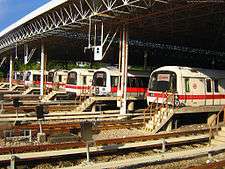
The cars that form a complete EMU set can usually be separated by function into four types: power car, motor car, driving car, and trailer car. Each car can have more than one function, such as a motor-driving car or power-driving car.
- A power car carries the necessary equipment to draw power from the electrified infrastructure, such as pickup shoes for third rail systems and pantographs for overhead systems, and transformers.
- Motor cars carry the traction motors to move the train, and are often combined with the power car to avoid high-voltage inter-car connections.
- Driving cars are similar to a cab car, containing a driver's cab for controlling the train. An EMU will usually have two driving cars at its outer ends.
- Trailer cars are any cars that carry little or no traction or power related equipment, and are similar to passenger cars in a locomotive-hauled train. On third rail systems the outer vehicles usually carry the pick up shoes, with the motor vehicles receiving the current via intra-unit connections.
Examples
Some of the more famous electric multiple units in the world are high-speed trains: the Shinkansen in Japan and ICE 3 in Germany. The retired New York–Washington Metroliner service, first operated by the Pennsylvania Railroad and later by Amtrak, also featured high-speed electric multiple-unit cars.
Gallery
-

German ICE 3 EMU (Deutsche Bahn)
-
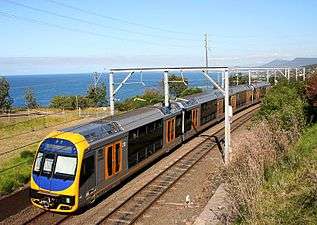
OSCAR (H-set) bilevel EMU operate in New South Wales, Australia
-
Spanish Civia EMU operate on commuter lines
-

A Malaysian KTM Komuter KTM Class 83 EMU at a Train station
-

A First ScotRail Class 380 EMU at Haymarket
-

A ex-JR East 205 series EMU train operated by KA Commuter Jabodetabek in Indonesia, Formerly JR East .
-
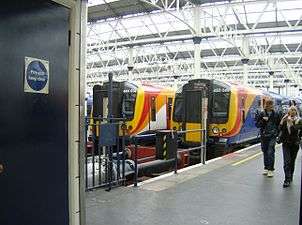
SWT Class 444 and Class 450 suburban units at London Waterloo station (UK)
-
Transperth B Series EMUs operate in Perth, Australia
-
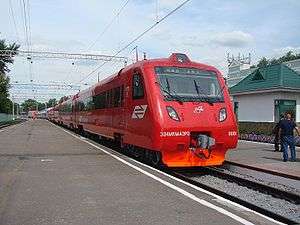
Russian ED4MKM-aero EMU
-

Iarnród Éireann 8520 Class EMU, operated on the DART line
-

Japanese JR West Shinkansen Type 500 EMU
-
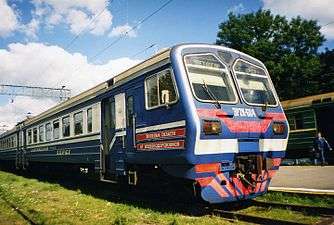
Russian ER2K EMU (No. 604)
-
New high-speed Gautrain of South Africa
-

Metro-North Railroad M8 in Port Chester, New York
-

Z 20500, used on Paris's RER and Transilien, France
-

Swiss Stadler FLIRT RABe 523
-

Greek Siemens Desiro used for commuter service
-
An NSB Class 73 (left) and a NSB Class 69 train at Nelaug Station.
-
_Milan%2C_m%C3%A9tro%2C_ligne_2.jpg)
An ET245 consist of Milan Metro in the original M2 livery.
-

The Italian ETR 232 (former 212) high-speed trainset which set a 203 km/h speed record in 1939.
-
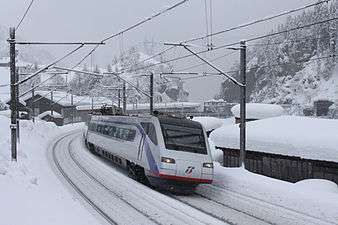
An ETR 470 high-speed, tilting EMU negotiating the sharp curves of the Gotthardbahn.
-
.jpg)
GE Silverliner IV EMU operated by SEPTA Regional Rail at Paoli.
-

A New Zealand AM class electric multiple unit at Puhinui Station in Auckland (AMA 103)
See also
| Wikimedia Commons has media related to Electric multiple units. |
References
- ↑ N. K. De (2004). Electric Drives. PHI Learning Pvt. Ltd. 8.4 "Electric traction", p.84.
- ↑ http://www.liverpoolmuseums.org.uk/mol/collections/transport/overheadrailway.aspx
|






